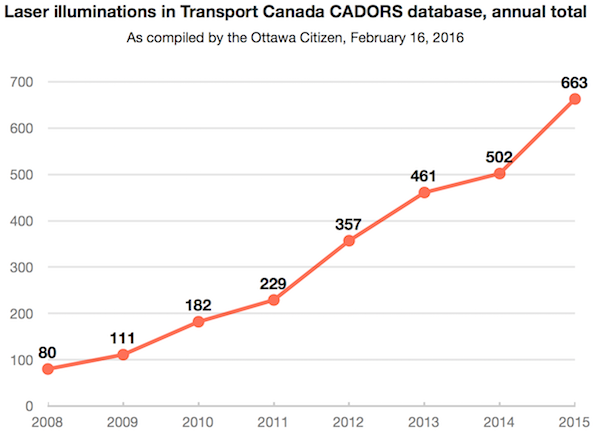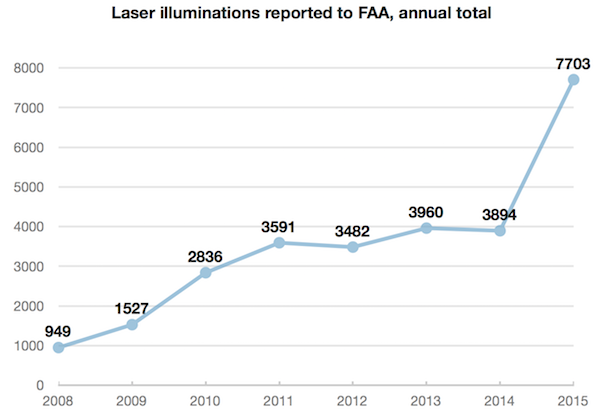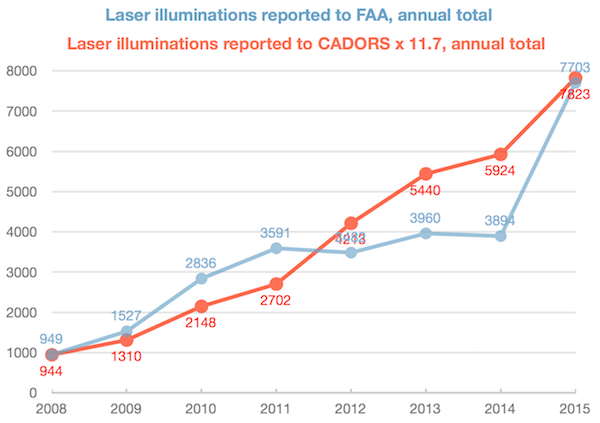Home
A comprehensive resource for safe and responsible laser use
Canada: Pilots want lasing aircraft to be a crime
12 Mar 2020 -- Categories: Bans & Restrictions | Labels and warnings | Eye effect or injury | Statistics | Laws | Ways to reduce incidents | SLA news
The president of the Canada section of the Air Line Pilots Association (ALPA) has said that lasing an aircraft in Canada should be made a criminal offense, and the government should launch an information campaign to discourage misuse. He also said high-powered lasers should have warning labels and require permits to use them.
Tim Perry made his proposals May 11 2020 after a Jazz Aviation pilot was hospitalized due to being illuminated by laser light on approach to Ottawa/Macdonald-Cartier International Airport, on February 15 2020. The laser source was about three nautical miles from the aircraft. The co-pilot of the de Havilland DHC-8-300 passenger aircraft had to turn control over to the captain, who was able to land without incident. The co-pilot was taken to hospital as a precaution due to actual or potential injuries. No additional information was made available by Jazz due to privacy restrictions.
Perry said that other Canadian aviators have actually suffered permanent retinal damage as a result of laser strikes, according to the National Post. Details on the Jazz pilot's condition, or on the other pilots — how many, degree of severity, eventual outcome — were not listed in the Post article. There were eye injury claims in February 2020 when an Ornge medical support aircraft was struck by a green laser in downtown Toronto, and an eye injury claim by a WestJet pilot flying from Newfoundland to Orlando in May 2019.
The article stated that "Most of the reports in the CADORS [aviation incident] database indicate that police were notified, but neither Transport Canada nor the RCMP [Royal Canadian Mounted Police] could cite an example of anyone in Canada ever being prosecuted." [Note: LaserPointerSafety.com has found at least four cases of Canadian prosecutions.]
Canada has previously taken steps to reduce laser/aircraft incidents. These may be having some effect, as laser incidents have been dropping from a reported high of 658 in 2015, to 274 in 2019, according to the National Post article.
On June 28 2018 Transport Minister Marc Garneau banned the use of hand-held lasers 1 milliwatt or more (the power of a small pet laser pointer) in Toronto, Montreal and Vancouver, and within 10 km of airports or heliports. There are exceptions for uses such as work, education, school or astronomy.
Any person with a battery-operated, handheld laser in a prohibited zone 1) outside of a private dwelling and 2) without a legitimate purpose can be fined immediately and “on the spot” up to CDN $5,000. A corporation violating the law can be fined up to CDN $25,000. The fines are in addition to any criminal prosecution; intentionally aiming a laser at an aircraft can result in five years in prison and/or up to CDN $100,000 in fines.
On May 24 2016, Garneau announced a social media awareness campaign. This included setting up a webpage in June 2015 that includes a catchy animated video, “Dumb Ways to Blind” aimed at millennials, plus three other more conventional videos on the topic. Transport Canada also tweeted using the hashtag "#NotABrightIdea".
Section 7.41(1) of Part I of the Canadian Aeronautics Act is a general prohibition against behavior that endangers aircraft. It provides a fine of up to CDN $100,000 and up to five years in prison for interfering with the duties of a crew member. This has been cited by Transport Canada as part of its webpages discouraging persons from aiming at aircraft.
From the National Post, March 11 2020. Note that there has been a discrepancy between newspaper reports of the number of annual laser/aircraft incidents, and Transport Canada figures. For more information, see the Canada section on the Laser/aircraft illumination statistics page. Thanks to Randy Paura for bringing this news to our attention.
Tim Perry made his proposals May 11 2020 after a Jazz Aviation pilot was hospitalized due to being illuminated by laser light on approach to Ottawa/Macdonald-Cartier International Airport, on February 15 2020. The laser source was about three nautical miles from the aircraft. The co-pilot of the de Havilland DHC-8-300 passenger aircraft had to turn control over to the captain, who was able to land without incident. The co-pilot was taken to hospital as a precaution due to actual or potential injuries. No additional information was made available by Jazz due to privacy restrictions.
Perry said that other Canadian aviators have actually suffered permanent retinal damage as a result of laser strikes, according to the National Post. Details on the Jazz pilot's condition, or on the other pilots — how many, degree of severity, eventual outcome — were not listed in the Post article. There were eye injury claims in February 2020 when an Ornge medical support aircraft was struck by a green laser in downtown Toronto, and an eye injury claim by a WestJet pilot flying from Newfoundland to Orlando in May 2019.
The article stated that "Most of the reports in the CADORS [aviation incident] database indicate that police were notified, but neither Transport Canada nor the RCMP [Royal Canadian Mounted Police] could cite an example of anyone in Canada ever being prosecuted." [Note: LaserPointerSafety.com has found at least four cases of Canadian prosecutions.]
Canada has previously taken steps to reduce laser/aircraft incidents. These may be having some effect, as laser incidents have been dropping from a reported high of 658 in 2015, to 274 in 2019, according to the National Post article.
On June 28 2018 Transport Minister Marc Garneau banned the use of hand-held lasers 1 milliwatt or more (the power of a small pet laser pointer) in Toronto, Montreal and Vancouver, and within 10 km of airports or heliports. There are exceptions for uses such as work, education, school or astronomy.
Any person with a battery-operated, handheld laser in a prohibited zone 1) outside of a private dwelling and 2) without a legitimate purpose can be fined immediately and “on the spot” up to CDN $5,000. A corporation violating the law can be fined up to CDN $25,000. The fines are in addition to any criminal prosecution; intentionally aiming a laser at an aircraft can result in five years in prison and/or up to CDN $100,000 in fines.
On May 24 2016, Garneau announced a social media awareness campaign. This included setting up a webpage in June 2015 that includes a catchy animated video, “Dumb Ways to Blind” aimed at millennials, plus three other more conventional videos on the topic. Transport Canada also tweeted using the hashtag "#NotABrightIdea".
Section 7.41(1) of Part I of the Canadian Aeronautics Act is a general prohibition against behavior that endangers aircraft. It provides a fine of up to CDN $100,000 and up to five years in prison for interfering with the duties of a crew member. This has been cited by Transport Canada as part of its webpages discouraging persons from aiming at aircraft.
From the National Post, March 11 2020. Note that there has been a discrepancy between newspaper reports of the number of annual laser/aircraft incidents, and Transport Canada figures. For more information, see the Canada section on the Laser/aircraft illumination statistics page. Thanks to Randy Paura for bringing this news to our attention.
Canada: 663 laser/aircraft incidents in 2015 based on newspaper analysis of CADORS data
A report published February 19 2016 in the Ottawa Citizen states that there were 663 laser incidents in Canada. This was based on the newspaper’s analysis of Transport Canada’s Civil Aviation Daily Occurrence Reporting System (CADORS). The paper noted that Transport Canada considers the reports preliminary and “subject to change.”
Here is the CADORS data:
Here is the CADORS data:

Compare this with the number of illuminations in the United States over the same period:

Canada’s data roughly tracks the U.S. data. Here are the two charts above, superimposed, with the CADORS numbers multiplied 11.7 times. The slope of the lines are similar for all but 2013/2014, and the endpoints are remarkably close.

From an analysis by Andrew Duffy in the Ottawa Citizen. Note that a few days earlier, CBC News stated that there were 590 laser/aircraft incidents in 2015. There is no indication as to reasons for the discrepancy.
Canada: List of many Canadian incidents
A story in the Vancouver Sun by Lori Culbert lists many Canadian incidents in recent years (2005-2009). Her reporting was based in part on searching Transport Canada's online reporting system CADORS. Culbert's list of incidents includes:
Culbert's story also lists the first attack LaserPointerSafety.com is aware of on a blimp: "A green light was pointed into the cockpit of a blimp over Victoria's [B.C.] shoreline in October 2005. [CADORS reported that] 'several laser attempts were made and the pilot said he was affected twice. Quite aggressive attempts were made by the person using the laser light according to the pilot.' "
- A Cessna pilot flying over downtown Vancouver on May 25 2009, who had "flash blindness for a few seconds"
- More than two dozen reports of lasers being directed at airplanes in British Columbia since 2000.
- About 100 incidents of laser beams pointed at aircraft across Canada, since 2005.
- A Cessna pilot in June 2008 who "experienced slight vision impairment, and for safety reasons requested a wide left-hand 270-degree turn ... for brightness recovery and a stabilized approach".
- A helicopter co-pilot in November 2007 who looked at a laser and "was experiencing sun spots [sic] in her vision, which continued for the remainder of the flight."
- At least three incidents, two in June and one in November 2008, where Royal Canadian Mounted Police pilots were targeted.
- In July 2008, a Calgary man was fined $1000 after pleading guilty to shining a laser at an Air Canada flight.
Culbert's story also lists the first attack LaserPointerSafety.com is aware of on a blimp: "A green light was pointed into the cockpit of a blimp over Victoria's [B.C.] shoreline in October 2005. [CADORS reported that] 'several laser attempts were made and the pilot said he was affected twice. Quite aggressive attempts were made by the person using the laser light according to the pilot.' "